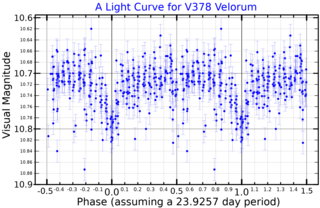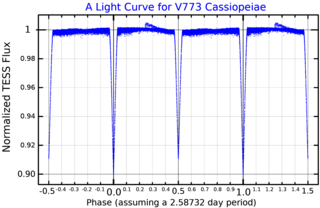
AR Aurigae, also known by its Flamsteed designation 17 Aurigae, is a binary star in the constellation Auriga. Based on parallax measurements made by the Hipparcos spacecraft, it is approximately 461 light-years from Earth.

Tau Canis Majoris is a multiple star system in the constellation Canis Major. It is approximately 5,000 light years distant from Earth and is the brightest member of the open cluster NGC 2362.

UW Canis Majoris is a star in the constellation Canis Major. It is classified as a Beta Lyrae eclipsing contact binary and given the variable star designation UW Canis Majoris. Its brightness varies from magnitude +4.84 to +5.33 with a period of 4.39 days. Bode had initially labelled it as Tau2 Canis Majoris, but this designation had been dropped by Gould and subsequent authors.

V357 Carinae is an astrometric and spectroscopic binary in the constellation Carina. It is approximately 419 light years from Earth. The mean apparent magnitude of the system is +3.43.

Rotating ellipsoidal variables are a class of close binary variable star systems whose components are ellipsoidal. They are not eclipsing, but fluctuations in apparent magnitude occur due to changes in the amount of light emitting area visible to the observer. Typical brightness fluctuations do not exceed 0.1 magnitudes.

EZ Canis Majoris is binary system in the constellation of Canis Major. The primary is a Wolf-Rayet star and it is one of the ten brightest Wolf-Rayet stars, brighter than apparent magnitude 7.

R Arae is an Algol-type eclipsing binary in the constellation Ara. Located approximately 298 parsecs (970 ly) distant, it normally shines at magnitude 6.17, but during eclipses can fall as low as magnitude 7.32. It has been suggested by multiple studies that mass transfer is occurring between the two stars of this system, and the period of eclipses seems to be increasing over time. The primary is a blue-white main sequence star of spectral type B5V that is 5 times as massive as the Sun, while the secondary is a yellow-white star of spectral type F1IV that is 1.5 times as massive as the Sun. Stellar material is being stripped off the secondary and accreting on the primary.

YZ Cassiopeiae is a star system 103.8 parsecs (339 ly) away from Earth, in the constellation Cassiopeia. It comprises three stars: an eclipsing Algol-type binary and a visually fainter star about 3000 AU distant.

R Canis Majoris is an eclipsing interacting binary star system in the constellation Canis Major. It varies from magnitude 5.7 to 6.34. The system is unusual in the low ratio between the main two components and shortness of the orbital period.

1 Persei is an eclipsing binary star in the constellation Perseus. Its uneclipsed apparent magnitude is 5.49. The binary star consists of two B2 type main-sequence stars in a 25.9 day eccentric orbit. The stars are surrounded by a faint cloud of gas visible in mid-infrared, although whether they are the origin of the gas or simply passing through it is unclear.

NS Puppis is an irregular variable star in the constellation Puppis. Its apparent magnitude varies between 4.4 and 4.5.

KQ Puppis is a spectroscopic binary variable star in the constellation Puppis. A red supergiant star and a hot main sequence star orbit each other every 9,742 days. Its apparent magnitude varies between 4.82 and 5.17.

HD 54893, often called A Puppis is a suspected variable star in the constellation Puppis. Its apparent magnitude is 4.83 and is approximately 860 light years away based on parallax.

W Crucis is a single-lined eclipsing variable star system in the constellation Crux. It has a spectral class of F8/G1Ia/abe indicating a yellow supergiant with emission lines in its spectrum.

ZZ Boötis is a star system in the constellation Boötes. It varies from magnitude 6.79 to 7.44 over five days. Based on its parallax, measured by the Gaia spacecraft, it is about 350 light-years away.
The O'Connell effect is an asymmetry in the photometric light curve of certain close eclipsing binary stars. It was named after the astronomer Daniel Joseph Kelly O'Connell, SJ of Riverview College in New South Wales who in 1951 studied this phenomenon and distinguished it from the so-called periastron effect described by earlier authors, as it does not necessarily appear near the periastron, when tidal effects and an increase in mutual radiation may cause an increase in luminosity.

HO Telescopii is an eclipsing binary star system located in the southern constellation of Telescopium. The maximum apparent visual magnitude of 8.22 is too faint to be visible to the naked eye. The system is located at a distance of approximately 910 light years based on parallax. The combined stellar classification of the system is A7III(m), matching an evolved A-type star that is possibly metallic-lined. The system is around 1.1 billion years old and consists of two stars of similar mass and size.

WR 12 is a spectroscopic binary in the constellation Vela. It is an eclipsing binary consisting of a Wolf-Rayet star and a luminous companion of unknown spectral type. The primary is one of the most luminous stars known.

ADS 1359 is a quadruple star system in the constellation Cassiopeia. It is composed of two sun like stars in an eclipsing binary with a 2.5-day period, which is in turn orbited by an A-type main-sequence star with a 185-year orbital period. There is also HD 236848 which is a distant proper motion companion.

HD 62058, is a variable star in the constellation Puppis. It is a rare yellow hypergiant and a candidate member of the open cluster NGC 2439. It is also an MK spectral standard for the class G2 0-Ia.














